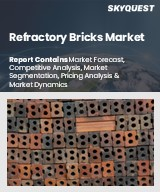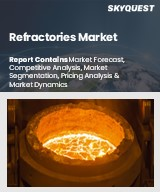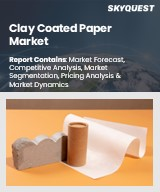
|
시장보고서
상품코드
1701529
세계의 슬레이트 시장 규모, 점유율, 성장 분석 : 제품 유형별, 용도별, 지역별 - 산업 예측(2025-2032년)Slate Market Size, Share, and Growth Analysis, By Product Type (Natural Slate, Synthetic Slate), By Application (Roof, Floor), By Region - Industry Forecast 2025-2032 |
||||||
슬레이트 시장 규모는 2023년 15억 9,000만 달러, 2024년 16억 7,000만 달러에서 2032년 24억 5,000만 달러로 성장할 것으로 예상되며, 예측 기간(2025-2032년) 동안 4.9%의 연평균 복합 성장률(CAGR)을 보일 것으로 예측됩니다.
세계 슬레이트 시장은 독특한 특성과 용도에 따라 꾸준한 수요를 보이고 있습니다. 슬레이트는 내구성과 미적 매력으로 유명하며, 전 세계의 다양한 건설 및 디자인 프로젝트에서 선호되고 있습니다. 건축가와 디자이너들은 지붕재, 바닥재, 벽재로 슬레이트를 사용하고 있습니다. 이 시장은 주거, 산업, 상업 건축 등 다양한 분야에서 활용되고 있으며, 지속 가능하고 오래 지속되는 재료에 대한 관심이 그 인기를 높이고 있습니다. 친환경적이고 에너지 효율적인 건축 방식에 대한 인식이 높아지면서 슬레이트에 대한 수요가 더욱 증가하고 있습니다. 그러나 지역적 가용성, 운송 비용, 대체 재료와의 경쟁은 시장 역학에 영향을 미칠 수 있습니다. 트렌드가 진화함에 따라 슬레이트 시장은 변화하는 미적 및 기능적 요구에 부응하는 시대를 초월한 솔루션을 제공하기 위해 계속 적응하고 있습니다.
목차
서론
- 조사 목적
- 조사 범위
- 정의
조사 방법
- 정보 조달
- 2차와 1차 데이터 방법
- 시장 규모 예측
- 시장 전제조건과 제한
주요 요약
- 세계 시장 전망
- 공급과 수요 동향 분석
- 부문별 기회 분석
시장 역학과 전망
- 시장 개요
- 시장 규모
- 시장 역학
- 성장 촉진요인과 기회
- 성장 억제요인과 과제
- Porter의 Five Forces 분석
주요 시장 인사이트
- 중요 성공 요인
- 경쟁 정도
- 주요 투자 기회
- 시장 생태계
- 시장의 매력 지수(2024년)
- PESTEL 분석
- 거시경제 지표
- 밸류체인 분석
- 가격 분석
슬레이트 시장 규모 : 제품 유형별
- 시장 개요
- 천연 슬레이트
- 합성 슬레이트
슬레이트 시장 규모 : 용도별
- 시장 개요
- 지붕
- 바닥
- 벽
슬레이트 시장 규모
- 북미
- 미국
- 캐나다
- 유럽
- 독일
- 스페인
- 프랑스
- 영국
- 이탈리아
- 기타 유럽
- 아시아태평양
- 중국
- 인도
- 일본
- 한국
- 기타 아시아태평양
- 라틴아메리카
- 브라질
- 기타 라틴아메리카
- 중동 및 아프리카
- GCC 국가
- 남아프리카공화국
- 기타 중동 및 아프리카
경쟁 정보
- 주요 5개사 비교
- 주요 기업의 시장 포지셔닝(2024년)
- 주요 시장 기업이 채택한 전략
- 최근 시장 동향
- 기업의 시장 점유율 분석(2024년)
- 주요 기업 개요
- 기업 상세
- 제품 포트폴리오 분석
- 기업 부문별 점유율 분석
- 매출 전년대비 비교(2022-2024년)
주요 기업 개요
- Vermont Structural Slate Company(USA)
- Glendyne Inc.(Canada)
- Cupa Pizarras(Spain)
- Delabole Slate Company(UK)
- The Vermont Slate Company(USA)
- Camara Slate Products(USA)
- Greenstone Slate Company(USA)
- Penrhyn Quarry(UK)
- Samaca Slate(Spain)
- Gallegas Slate(Spain)
- Villar del Rey Natural Slate(Spain)
- Stone Panels International LLC(USA)
- New England Slate Company(USA)
- North Country Slate(Canada)
- Stone Roofing Company(USA)
- American Slate Company(USA)
- Slate Valley Museum(USA)
- Monson Maine Slate Company(USA)
- Middlebury Slate Company(USA)
- Evergreen Slate Company(USA)
결론과 제안
LSH 25.05.22Slate Market size was valued at USD 1.59 billion in 2023 and is poised to grow from USD 1.67 billion in 2024 to USD 2.45 billion by 2032, growing at a CAGR of 4.9% during the forecast period (2025-2032).
The global slate market exhibits a consistent demand driven by its unique properties and applications. Known for its durability and aesthetic appeal, slate remains a favored choice in various construction and design projects worldwide. Architects and designers opt for slate in roofing, flooring, and wall cladding due to its elegance and resilience across diverse climates. This market serves multiple sectors, including residential, industrial, and commercial construction, where the focus on sustainable and long-lasting materials enhances its popularity. Increased awareness of eco-friendly and energy-efficient building practices is further boosting slate's demand. However, regional availability, transportation costs, and competition from alternative materials could influence market dynamics. As trends evolve, the slate market continues to adapt, offering timeless solutions that cater to changing aesthetic and functional needs.
Top-down and bottom-up approaches were used to estimate and validate the size of the Slate market and to estimate the size of various other dependent submarkets. The research methodology used to estimate the market size includes the following details: The key players in the market were identified through secondary research, and their market shares in the respective regions were determined through primary and secondary research. This entire procedure includes the study of the annual and financial reports of the top market players and extensive interviews for key insights from industry leaders such as CEOs, VPs, directors, and marketing executives. All percentage shares split, and breakdowns were determined using secondary sources and verified through Primary sources. All possible parameters that affect the markets covered in this research study have been accounted for, viewed in extensive detail, verified through primary research, and analyzed to get the final quantitative and qualitative data.
Slate Market Segments Analysis
Global Slate Market is segmented by Product Type, Application and region. Based on Product Type, the market is segmented into Natural Slate and Synthetic Slate. Based on Application, the market is segmented into Roof, Floor and Wall. Based on region, the market is segmented into North America, Europe, Asia Pacific, Latin America and Middle East & Africa.
Driver of the Slate Market
With the increasing emphasis on environmental sustainability, architects, builders, and consumers are increasingly seeking durable and eco-friendly materials, leading to a heightened interest in slate. This natural stone, renowned for its longevity and energy-efficient properties, presents itself as an appealing option for sustainable construction. Its ability to combine aesthetics with functionality makes slate a favored choice, thus significantly boosting demand in the market. As more stakeholders prioritize green building practices, the appeal of slate continues to grow, reinforcing its position as a key player in the quest for environmentally responsible construction materials.
Restraints in the Slate Market
A significant constraint impacting the global slate market is the competition from alternative materials, such as synthetic roofing solutions and engineered flooring options. These alternatives often offer cost advantages and lower maintenance requirements, which challenge the traditional slate products. To maintain their market position, players in the slate industry must focus on innovation and address pricing concerns while also emphasizing the unique features and benefits of slate. This approach is essential for overcoming the competition posed by these alternative products and sustaining demand within the market.
Market Trends of the Slate Market
The slate market is experiencing a significant transformation driven by the rising embrace of digital marketing and e-commerce. As traditional marketing approaches evolve, slate manufacturers and distributors are leveraging online platforms to effectively reach a wider audience. The convenience of seamless online ordering, enhanced digital product presentations, and improved customer engagement is reshaping how slate products are marketed. This shift not only boosts operational efficiency but also expands the market reach for stakeholders in the slate industry. The trend indicates a growing reliance on digital strategies to connect with consumers, positioning e-commerce as a crucial component of market growth and competitiveness.
Table of Contents
Introduction
- Objectives of the Study
- Scope of the Report
- Definitions
Research Methodology
- Information Procurement
- Secondary & Primary Data Methods
- Market Size Estimation
- Market Assumptions & Limitations
Executive Summary
- Global Market Outlook
- Supply & Demand Trend Analysis
- Segmental Opportunity Analysis
Market Dynamics & Outlook
- Market Overview
- Market Size
- Market Dynamics
- Drivers & Opportunities
- Restraints & Challenges
- Porters Analysis
- Competitive rivalry
- Threat of substitute
- Bargaining power of buyers
- Threat of new entrants
- Bargaining power of suppliers
Key Market Insights
- Key Success Factors
- Degree of Competition
- Top Investment Pockets
- Market Ecosystem
- Market Attractiveness Index, 2024
- PESTEL Analysis
- Macro-Economic Indicators
- Value Chain Analysis
- Pricing Analysis
Global Slate Market Size by Product Type & CAGR (2025-2032)
- Market Overview
- Natural Slate
- Synthetic Slate
Global Slate Market Size by Application & CAGR (2025-2032)
- Market Overview
- Roof
- Floor
- Wall
Global Slate Market Size & CAGR (2025-2032)
- North America (Product Type, Application)
- US
- Canada
- Europe (Product Type, Application)
- Germany
- Spain
- France
- UK
- Italy
- Rest of Europe
- Asia Pacific (Product Type, Application)
- China
- India
- Japan
- South Korea
- Rest of Asia-Pacific
- Latin America (Product Type, Application)
- Brazil
- Rest of Latin America
- Middle East & Africa (Product Type, Application)
- GCC Countries
- South Africa
- Rest of Middle East & Africa
Competitive Intelligence
- Top 5 Player Comparison
- Market Positioning of Key Players, 2024
- Strategies Adopted by Key Market Players
- Recent Developments in the Market
- Company Market Share Analysis, 2024
- Company Profiles of All Key Players
- Company Details
- Product Portfolio Analysis
- Company's Segmental Share Analysis
- Revenue Y-O-Y Comparison (2022-2024)
Key Company Profiles
- Vermont Structural Slate Company (USA)
- Company Overview
- Business Segment Overview
- Financial Updates
- Key Developments
- Glendyne Inc. (Canada)
- Company Overview
- Business Segment Overview
- Financial Updates
- Key Developments
- Cupa Pizarras (Spain)
- Company Overview
- Business Segment Overview
- Financial Updates
- Key Developments
- Delabole Slate Company (UK)
- Company Overview
- Business Segment Overview
- Financial Updates
- Key Developments
- The Vermont Slate Company (USA)
- Company Overview
- Business Segment Overview
- Financial Updates
- Key Developments
- Camara Slate Products (USA)
- Company Overview
- Business Segment Overview
- Financial Updates
- Key Developments
- Greenstone Slate Company (USA)
- Company Overview
- Business Segment Overview
- Financial Updates
- Key Developments
- Penrhyn Quarry (UK)
- Company Overview
- Business Segment Overview
- Financial Updates
- Key Developments
- Samaca Slate (Spain)
- Company Overview
- Business Segment Overview
- Financial Updates
- Key Developments
- Gallegas Slate (Spain)
- Company Overview
- Business Segment Overview
- Financial Updates
- Key Developments
- Villar del Rey Natural Slate (Spain)
- Company Overview
- Business Segment Overview
- Financial Updates
- Key Developments
- Stone Panels International LLC (USA)
- Company Overview
- Business Segment Overview
- Financial Updates
- Key Developments
- New England Slate Company (USA)
- Company Overview
- Business Segment Overview
- Financial Updates
- Key Developments
- North Country Slate (Canada)
- Company Overview
- Business Segment Overview
- Financial Updates
- Key Developments
- Stone Roofing Company (USA)
- Company Overview
- Business Segment Overview
- Financial Updates
- Key Developments
- American Slate Company (USA)
- Company Overview
- Business Segment Overview
- Financial Updates
- Key Developments
- Slate Valley Museum (USA)
- Company Overview
- Business Segment Overview
- Financial Updates
- Key Developments
- Monson Maine Slate Company (USA)
- Company Overview
- Business Segment Overview
- Financial Updates
- Key Developments
- Middlebury Slate Company (USA)
- Company Overview
- Business Segment Overview
- Financial Updates
- Key Developments
- Evergreen Slate Company (USA)
- Company Overview
- Business Segment Overview
- Financial Updates
- Key Developments



















